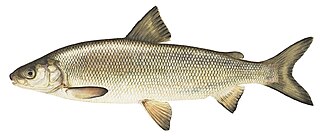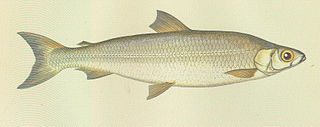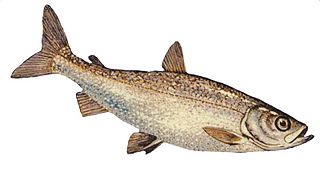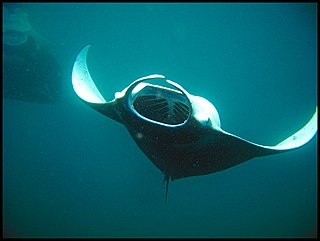
Coregonus is a diverse genus of fish in the salmon family (Salmonidae). The Coregonus species are known as whitefishes. The genus contains at least 68 described extant taxa, but the true number of species is a matter of debate. The type species of the genus is Coregonus lavaretus.

The Dolly Varden trout is a species of salmonid ray-finned fish native to cold-water tributaries of the Pacific Ocean in Asia and North America. Despite the name "trout", it belongs to the genus Salvelinus (chars), which includes 51 recognized species, the most prominent being the brook, lake and bull trout as well as the Arctic char. Although many populations are semi-anadromous, riverine and lacustrine populations occur throughout its range. It is considered by taxonomists as part of the Salvelinus alpinus complex, as many populations of bull trout, Dolly Varden trout and Arctic char overlap.

The pollan or Irish pollan is a freshwater whitefish known only from five Irish lakes, Lough Neagh, Lower Lough Erne, Lough Ree, Lough Derg and Lough Allen. The pollan faces competition from introduced species such as pike, roach and zebra mussel, and the populations rely on restocking for survival.

The lake chub is a freshwater cyprinid fish found in Canada and in parts of the United States. Of all North American minnows, it is the one with the northernmost distribution. Its genus, Couesius is considered monotypic today. The genus was named after Elliott Coues, who collected the holotype specimen.

The Arctic lamprey, also known as the Japanese river lamprey or Japanese lampern, is a species of lamprey, a jawless fish in the order Petromyzontiformes. It inhabits coastal freshwater habitat types in the Arctic. Some populations are anadromous, spending part of their lives in the ocean. It is the most common and widespread lamprey in the Arctic region.

Arctic cisco, also known as omul, is an anadromous species of freshwater whitefish that inhabits the Arctic parts of Siberia, Alaska and Canada. It has a close freshwater relative in several lakes of Ireland, known as the pollan, alternatively regarded as conspecific with it, or as a distinct species.

The broad whitefish is a freshwater whitefish species. Dark silvery in colour, and like a herring in its shape. Its distinctive features includes: a convex head, short gill rakers, and a mild overbite. It is found in the Arctic-draining streams, lakes, and rivers of far eastern Russia and North America. Its prey includes larval insects, snails, and shellfish. It is eaten by humans and brown bears.

The rainbow smelt is a North American species of fish of the family Osmeridae. Walleye, trout, and other larger fish prey on these smelt. The rainbow smelt prefer juvenile ciscoes, zooplankton such as calanoid copepods, and other small organisms, but are aggressive and will eat almost any fish they find. They are anadromous spring spawners and prefer clean streams with light flow and light siltation. The rainbow smelt face several barriers. They are weak swimmers and struggle to navigate fish ladders preventing them from making it past dams to the headwater streams where they spawn. The rise in erosion and dams helped to decimate the smelt population in the 1980s. There are currently plans to try to reduce damming and to help control erosion.

The longnose sucker is a species of cypriniform freshwater fish in the family Catostomidae. It is native to North America from the northern United States to the top of the continent. It is also found in Russia in rivers of eastern Siberia, and this one of only two species of sucker native to Asia.

The mountain whitefish is one of the most widely distributed salmonid fish of western North America. It is found from the Mackenzie River drainage in Northwest Territories, Canada through western Canada and the northwestern USA in the Pacific, Hudson Bay and upper Missouri River basins to the Truckee River drainage in Nevada and Sevier River drainage in Utah.

Coregonus hoyi, also known as the bloater, is a species or form of freshwater whitefish in the family Salmonidae. It is a silvery-coloured herring-like fish, 25.5 centimetres (10.0 in) long. It is found in most of the Great Lakes and in Lake Nipigon, and inhabits underwater slopes. This fish is not to be confused with the extinct deepwater cisco, a large fish that shared a common name with the bloater.

The shortjaw cisco is a North-American freshwater whitefish in the salmon family. Adult fish range to about 30 cm (12 in) in length and are silver, tinged with green above and paler below. One of the members of the broader Coregonus artedi complex of ciscoes, it is distributed widely in the deeper lakes of Canada, but populations in the Great Lakes have been declining and it is no longer present in Lakes Michigan, Huron, and Erie. It feeds mainly on crustaceans and insect larvae and spawns in the autumn on the lake bed. It is part of the important cisco (chub) fishery in the Great Lakes. The International Union for Conservation of Nature has rated its conservation status as "vulnerable". Shortjaw cisco have however evolved from the cisco Coregonus artedi independently in different lakes and different parts of the range, and conservation assessments therefore should be made on a lake-wise rather than range-wide basis.

The freshwater whitefish are fishes of the subfamily Coregoninae, which contains whitefishes and ciscoes, and is one of three subfamilies in the salmon family Salmonidae. Apart from the subfamily Coregoninae, the family Salmonidae includes the salmon, trout, and char species of the subfamily Salmoninae, and grayling species of the subfamily Thymallinae. Freshwater whitefish are distributed mainly in relatively cool waters throughout the northern parts of the Northern Hemisphere.
The wildlife of Alaska is both diverse and abundant. The Alaskan Peninsula provides an important habitat for fish, mammals, reptiles, and birds. At the top of the food chain are the bears. Alaska contains about 70% of the total North American brown bear population and the majority of the grizzly bears, as well as black bears and Kodiak bears. In winter, polar bears can be found in the Kuskokwim Delta, St. Matthew Island, and at the southernmost portion of St. Lawrence Island. Other major mammals include moose and caribou, bison, wolves and wolverines, foxes, otters and beavers. Fish species are extensive, including: salmon, graylings, char, rainbow and lake trout, northern pike, halibut, pollock, and burbot. The bird population consists of hundreds of species, including: bald eagles, owls, falcons, ravens, ducks, geese, swans, and the passerines. Sea lions, seals, sea otters, and migratory whales are often found close to shore and in offshore waters. The Alaskan waters are home to two species of turtles, the leatherback sea turtle and the green sea turtle. Alaska has two species of frogs, the Columbia spotted frog and wood frog, plus two introduced species, the Pacific tree frog and the red-legged frog. The only species of toad in Alaska is the western toad. There are over 3,000 recorded species of marine macroinvertebrates inhabiting the marine waters, the most common being the various species of shrimp, crab, lobster, and sponge.

The humpback whitefish, also referred to as the bottom whitefish, the Arctic whitefish or the pidschian, is a species of freshwater whitefish with a northern distribution. It is one of the members in the broader common whitefish complex, or the Coregonus clupeaformis complex. This fish lives in estuaries and brackish water near river mouths, in deltas and in slowly running rivers, in large lakes with tributaries, and floodplain lakes. It can migrate long distances upriver for spawning.

The pygmy whitefish is a freshwater whitefish of the genus Prosopium in the family Salmonidae. Found in the mountain streams and lakes in western North America, it also has isolated populations in Lake Superior and in Ekityki Lake, Chukchi Peninsula.

Silverjaw minnows are part of the family Cyprinidae, which includes carps and minnows. With over 300 known species, there are more species of minnows native to North America's fresh waters than any other fish. Minnows can be hard to distinguish because many look alike. All minnows have one dorsal fin, ventral fins near the anus, a lateral line system, and smooth, round cycloid scales. Their jaws lack teeth, but they have one to three rows of pharyngeal teeth to grind food. Defining physical characteristics such as the number and type of fin rays, type of scales, and pattern of pharyngeal teeth are used to distinguish minnows.

The Bering cisco or Lauretta whitefish is a freshwater whitefish found in Alaska and part of Russia. It is often considered to be the same species as the more common Arctic cisco.

The lake whitefish is a species of freshwater whitefish from North America. Lake whitefish are found throughout much of Canada and parts of the northern United States, including all of the Great Lakes. The lake whitefish is sometimes referred to as a "humpback" fish due to the small size of the head in relation to the length of the body. It is a valuable commercial fish, and also occasionally taken by sport fishermen. Smoked, refrigerated, vacuum-packed lake whitefish fillets are available in North American grocery stores. Other vernacular names used for this fish include Otsego bass, Sault whitefish, gizzard fish, common whitefish, eastern whitefish, Great Lakes whitefish, humpback whitefish, inland whitefish and whitefish.

A planktivore is an aquatic organism that feeds on planktonic food, including zooplankton and phytoplankton. Planktivorous organisms encompass a range of some of the planet's smallest to largest multicellular animals in both the present day and in the past billion years; basking sharks and copepods are just two examples of giant and microscopic organisms that feed upon plankton.

















